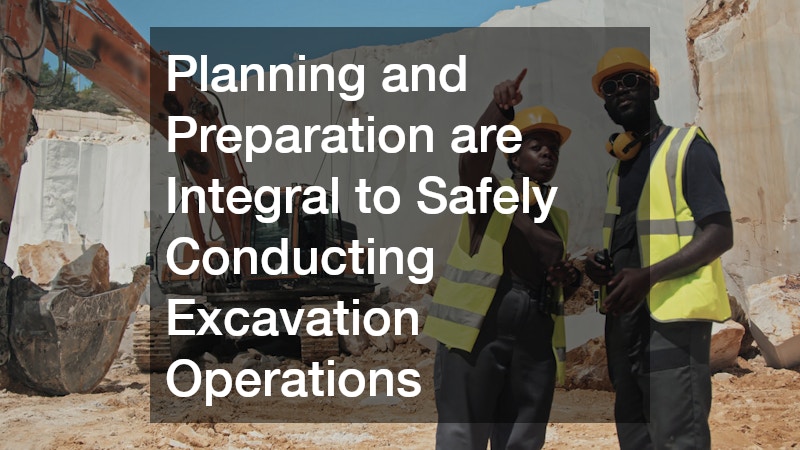Excavation is an essential construction activity but presents numerous potential hazards if not executed correctly. Understanding the fundamental principles of excavation safety is the first step toward preventing accidents. Trenching and excavation involve significant risks such as cave-ins, falls, or even hazardous atmospheres, which require diligent preparation and ongoing safety measures.
Therefore, getting acquainted with the geotechnical characteristics of the jobsite is crucial. Knowing the soil type, weather conditions, and proximity to underground utilities will inform and guide the safety strategies implemented on site.
Training is another crucial component in ensuring safety during excavation. Workers should undergo comprehensive safety training, which covers the risks associated with trenching and excavation and the preventative measures that can mitigate these dangers. This training should emphasize the importance of vigilance and recognition of potentially dangerous situations. Additionally, empowering workers to report unsafe practices without fear of retaliation encourages a proactive approach to safety. Implementing frequent safety audits and regular refresher courses keeps safety protocols at the forefront of workers’ minds.
The utilization of protective systems, such as trench shields, trench boxes, or shoring, is a vital part of ensuring excavation safety. These systems are designed to protect workers from cave-ins, which is the leading cause of fatalities in trenching operations. Selecting and implementing the appropriate protective system depends on the depth and width of the trench, as well as soil type and environmental factors. Regular inspections of these protective systems must be conducted to ensure their functionality and integrity. Ultimately, maintaining a disciplined approach to safety management can significantly mitigate the risks associated with excavation activities.
The Role of Planning and Preparation
Careful planning and preparation are integral to safely conducting trenching and excavation operations. Detailed site assessments and project planning must precede any excavation work to identify and address potential hazards. This includes mapping existing utilities, such as gas, water, and electric lines, to avoid inadvertent strikes, which can have catastrophic consequences. Coordination with utility companies and local authorities ensures that all parties are aware of the planned activities and any associated risks. Scheduling excavation activities around favorable weather conditions, avoiding rain or frost when possible, further reduces risks.
Incorporating a robust risk management plan into the preparation process is paramount. This plan should outline the specific risks associated with the excavation project, along with strategies for managing and mitigating these risks. For example, understanding and planning for potential cave-ins requires thorough soil analysis and the application of appropriate trench protection measures. Contingency plans for emergencies, such as worker injuries or utility strikes, should also be established. By preparing for the worst-case scenarios, project managers demonstrate their commitment to safety and readiness to handle unexpected challenges.
Resource allocation is another critical aspect of preparation. Ensuring that the appropriate equipment, such as excavators, shoring devices, and personal protective equipment, is readily available can significantly enhance safety and efficiency. In addition, assigning roles and responsibilities for safety oversight and emergency response ensures accountability and preparedness. Regularly updating and reviewing the excavation plan ensures that it is aligned with current safety standards and site conditions. By investing time and resources in meticulous planning and preparation, construction teams can drastically reduce the likelihood of accidents and improve project outcomes.
Implementing Effective Site Control Measures
Maintaining control over the job site is crucial for effective trenching and excavation. Setting up a perimeter with barriers and warning signs minimizes the potential for unauthorized personnel to enter the hazardous area. Designated walkways should be clearly marked to provide a safe path for both workers and equipment movement, helping to prevent accidental cave-ins and falls. Establishing check-in and check-out procedures ensures that all personnel are accounted for before work begins and concludes each day. Moreover, enforcing strict entry and exit protocols mitigates unauthorized access to excavation sites, enhancing overall safety.
Regular site inspections are an essential element of maintaining site control and safety. These inspections should be conducted by qualified personnel who can effectively identify potential hazards and deviations from safety standards. The ability to rapidly address any issues that arise during these inspections is critical for maintaining a safe work environment. Additionally, encouraging worker participation in identifying hazards promotes a culture of vigilance and shared responsibility. Site control measures, when rigorously enforced, build a consistent framework that reinforces safety as a daily operational priority.
Communication plays a vital role in ensuring the efficiency and safety of excavation operations. Establishing clear lines of communication between all stakeholders, including foremen, safety officers, and construction personnel, is essential for coordinating activities and preventing misunderstandings. Utilizing technology, such as mobile radios or site-specific communication applications, can enhance real-time information exchange. Regular safety briefings and toolbox talks should be integrated into daily routines to discuss ongoing or upcoming tasks and their associated safety considerations. Effective communication not only improves operational efficiency but also significantly enhances safety awareness, contributing to a secure excavation site.


